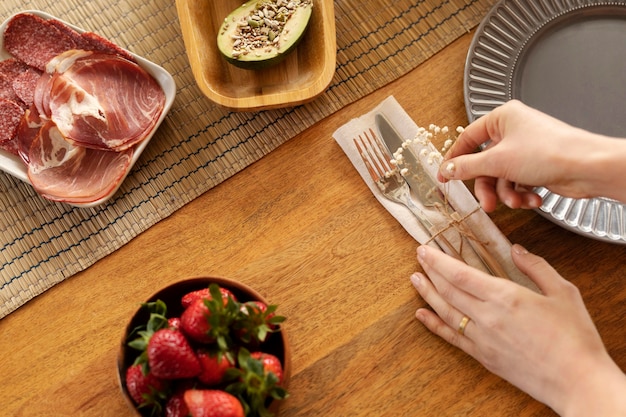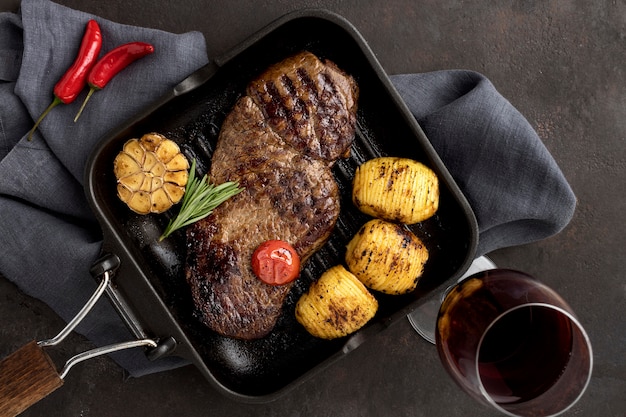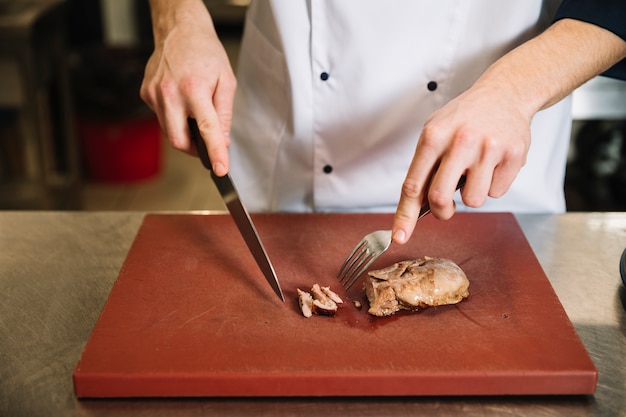(Part 1) Choosing Your Steak: A Guide to Cuts and Grades

The Cuts: A World of Steak Options
- Rib-Eye: Ah, the classic. Rib-eye is a crowd-pleaser for a reason. It's marbled with fat, which translates to an incredibly flavorful and tender experience. This is the steak for you if you want a rich, buttery flavor with a nice chew. Think of it as the steak with the most personality!
- strip steak (new york strip): Similar to ribeye, but with a slightly leaner profile. It's still fantastic, especially if you prefer a bit less fat and a more pronounced beefy flavor. It's a great all-rounder, perfect for grilling or pan-searing.
- Sirloin: A reliable choice, sirloin is a leaner option than ribeye and strip. It's perfect for grilling or pan-searing and holds its own well in various cooking methods.
- Tenderloin (filet mignon): This is the king of tenderness. It's the leanest cut, so it's best cooked quickly over high heat to prevent it from drying out. This is the steak for special occasions, when you want an incredibly delicate and melt-in-your-mouth experience.
- flank steak: This is a more flavorful and budget-friendly choice, but it’s also tougher than other cuts. It’s a great candidate for marinating and grilling, as it benefits from being cooked to medium-well, resulting in a tender and flavorful result.
Grading: Understanding the Quality
You'll often see steak labeled with a grade, such as USDA Prime, Choice, or Select. These grades indicate the quality of the meat based on factors like marbling (the amount of fat interwoven with the muscle), maturity, and color.
- Prime: The highest grade, Prime boasts the most marbling, resulting in the most flavorful and tender steak. It’s a treat usually found in high-end restaurants and specialty butchers.
- Choice: A good quality steak with a decent amount of marbling, Choice is readily available at most grocery stores.
- Select: The leanest grade, Select has less marbling. While still perfectly edible, it might be a bit tougher and less flavorful compared to its higher-grade counterparts.
My advice? Don’t be afraid to experiment! Try a different cut each time you cook a steak. You might be surprised by the delicious discoveries you make!
(Part 2) The Art of Preparation: Getting Your Steak Ready

Temperature is Key: Bring It to Room Temperature
One of the most common steak mistakes is cooking it straight from the refrigerator. A cold steak won't cook evenly, resulting in a tough, unevenly cooked piece of meat. Instead, take your steak out of the fridge about 30 minutes before cooking. This allows it to reach room temperature, which helps it cook more evenly. It also prevents the steak from getting cold shock when you hit it with high heat, leading to a more consistent sear.
Pat it Dry: A Dry Surface for a perfect sear
Once your steak is at room temperature, pat it dry with paper towels. This simple step makes a big difference! Wet surfaces don’t sear well, resulting in a steamy situation that prevents a crispy crust. By ensuring a dry surface, you're setting the stage for a beautiful, golden-brown sear.
Seasoning: Unlocking Flavor
Now for the fun part: seasoning! I'm a firm believer in keeping it simple with salt and pepper. A generous amount of coarse salt brings out the natural flavors of the meat, while freshly ground black pepper adds a bit of spice. I typically season my steak about 30 minutes before cooking. This allows the salt to draw out some of the moisture, promoting a more flavorful and tender result.
Oil It Up: A Smooth Surface for Even Browning
Before you even think about putting your steak on the heat, give it a light coating of oil. This step prevents sticking and promotes even browning, resulting in a beautiful, golden-brown crust. Olive oil is my go-to, but feel free to experiment with other oils like vegetable oil, avocado oil, or even melted butter.
Now, you’re ready for the grand finale: cooking your steak!
(Part 3) The Heat Is On: Mastering Different Cooking Methods

Grilling: The Classic Choice
Grilling is a classic way to cook steak, and for good reason. It delivers a smoky flavor and those beautiful grill marks that make your steak look like a million bucks. To grill a steak, heat your grill to high heat. You want those grates scorching hot. Place the steak on the grill and cook for 3-4 minutes per side. Don’t move it around too much! Let it get a good sear before you flip it. That sear is what gives you that delicious crispy crust.For a medium-rare steak, aim for an internal temperature of 130-135°F. I like to use a meat thermometer to ensure it's cooked to perfection. After you’ve seared both sides, move the steak to a cooler part of the grill for indirect heat, and cook until it reaches your desired internal temperature.
Pan-Searing: A Quick and Easy Option
Pan-searing is a fantastic option if you don’t have a grill, or if you’re looking for a quick and easy way to cook steak. To pan-sear a steak, heat a heavy-bottomed skillet over medium-high heat. Add a tablespoon of oil, swirl it around, and let it get nice and hot. Place the steak in the skillet and cook for 3-4 minutes per side. Once the steak has a good sear, reduce the heat to medium and cook for an additional 3-4 minutes, or until it reaches your desired internal temperature.
reverse searing: A Technique for Tenderness
Reverse searing is a technique that involves cooking the steak in a low oven for an extended period, and then finishing it on a hot grill or in a pan. This method yields an incredibly tender and juicy steak, especially for thicker cuts. To reverse sear a steak, preheat your oven to 250°F. Place the steak on a rack over a baking sheet. Cook for 30-45 minutes, depending on the thickness of the steak, until the internal temperature reaches 125°F for medium-rare. Once the steak is at the desired temperature, remove it from the oven and let it rest for 10 minutes. Then, sear the steak on a hot grill or in a skillet for 1-2 minutes per side to get a beautiful crust.
Cast Iron: A Versatile Tool for Steak
cast iron skillets are a kitchen staple, and they’re perfect for cooking steak. The heavy metal retains heat well, allowing for even cooking and a crispy crust. To cook steak in a cast iron skillet, heat the skillet over medium-high heat. Add a tablespoon of oil, swirl it around, and let it get nice and hot. Place the steak in the skillet and cook for 3-4 minutes per side. Once the steak has a good sear, reduce the heat to medium and cook for an additional 3-4 minutes, or until it reaches your desired internal temperature.
The Final Touch: Resting Your Steak
After cooking your steak, resist the urge to dig in right away. Let it rest for 5-10 minutes before slicing. This allows the juices to redistribute throughout the meat, resulting in a more tender and flavorful steak. Think of it as a crucial step in achieving that juicy, satisfying bite.
(Part 4) The Science of Doneness: Understanding Internal Temperatures
Cooking a steak is all about hitting that sweet spot of doneness. There’s a science to it, and knowing your internal temperatures is essential to achieving steak perfection.
Doneness Chart:
| Doneness | Internal Temperature (°F) | Description |
|---|---|---|
| Rare | 120-125 | Cool red center, very soft texture |
| Medium-Rare | 130-135 | Warm red center, soft but slightly firmer |
| Medium | 140-145 | Pink center, firmer texture |
| Medium-Well | 150-155 | Very little pink, firmer texture |
| Well-Done | 160 | No pink, firm texture |
Use a meat thermometer to check the internal temperature of your steak. It’s the most accurate way to ensure that it's cooked to your liking. Don't rely on visual cues alone; the thermometer is your trusted guide to achieving perfect doneness.
(Part 5) steak sauces: Taking It to the Next Level
A delicious steak deserves a fantastic sauce to complement its rich flavor.
The Classics:
- Béarnaise Sauce: A rich and creamy sauce made with egg yolks, butter, vinegar, and tarragon. It's a classic pairing for steak, adding a touch of elegance and sophistication. Its creamy texture and herbaceous flavor enhance the richness of the steak.
- Peppercorn Sauce: A robust and flavorful sauce made with black peppercorns, butter, and cream. It's a perfect match for a well-seasoned steak. The bold peppercorn flavor cuts through the richness of the meat, creating a delicious contrast.
- Red Wine Sauce: A simple and versatile sauce made with red wine, shallots, and butter. It's a great way to enhance the flavor of any steak. Its savory, slightly tangy flavor pairs beautifully with the natural flavors of the steak.
Get Creative:
- Gorgonzola Sauce: This creamy sauce, made with blue cheese, cream, and garlic, adds a pungent and savory kick to your steak. The blue cheese adds a distinct, salty depth to the sauce, while the cream and garlic create a smooth and comforting base.
- Mushroom Sauce: This earthy sauce, made with sauteed mushrooms, cream, and herbs, is a delicious and satisfying accompaniment to any steak. The earthy flavors of the mushrooms and herbs blend seamlessly with the richness of the steak, creating a well-rounded flavor profile.
- Garlic Herb Sauce: This simple sauce, made with garlic, herbs, and butter, adds a fresh and aromatic flavor to your steak. It's light and bright, letting the flavors of the steak shine through while adding a refreshing touch.
Don’t be afraid to experiment with different sauces and find your own favorites. I’ve learned that a little creativity can go a long way! The best sauces often come from playing around in the kitchen and discovering new flavor combinations.
(Part 6) Sides: The Perfect Compliment
No steak is complete without a fantastic side dish. Here are a few of my go-to choices:
The Classics:
- mashed potatoes: Creamy, comforting, and the perfect foil for a juicy steak. The creamy texture of mashed potatoes provides a beautiful contrast to the tenderness of the steak, while the richness of the potatoes enhances the overall experience.
- Roasted Vegetables: A healthy and flavorful way to add color and texture to your plate. The caramelized sweetness of roasted vegetables complements the savory flavors of the steak, offering a delightful balance of tastes and textures.
- Asparagus: This spring vegetable is a perfect match for steak, offering a delicate sweetness and a light crunch. Asparagus adds a touch of freshness to the meal, while its slightly bitter notes create a nice contrast to the rich steak.
Get Creative:
- potato gratin: This cheesy, creamy potato dish is a decadent and comforting side dish. It's a more sophisticated take on mashed potatoes, offering a luxurious texture and cheesy flavor that complements the steak beautifully.
- Mac and Cheese: A classic comfort food that pairs perfectly with a juicy steak. The creamy, cheesy goodness of mac and cheese is a perfect match for the savory flavors of the steak, creating a classic and comforting pairing.
- grilled corn on the Cob: A smoky and flavorful side dish that adds a touch of sweetness to your meal. The charred sweetness of grilled corn on the cob adds a contrasting element to the steak, offering a delightful mix of flavors and textures.
There are endless possibilities when it comes to side dishes. Get creative and have fun with it! The best pairings often come from experimenting and discovering what complements your chosen steak and your own taste preferences.
(Part 7) Steak Don’ts: Avoiding Common Mistakes
You've learned the basics, but there are some common mistakes that can ruin even the best steak. Here are a few things to avoid:
Don’t Overcook It:
One of the biggest steak sins is overcooking it. An overcooked steak is tough, dry, and flavorless. Pay close attention to the internal temperature and don’t cook it past your desired level of doneness. A meat thermometer is your best friend in this situation, helping you avoid the dreaded overcooked steak.
Don’t Poke It Too Much:
Resist the urge to constantly poke and prod your steak while it’s cooking. This can cause the juices to escape, leaving you with a dry and tough steak. Let it cook undisturbed for the most part, only checking the internal temperature with a thermometer as needed.
Don’t Skip the Resting Period:
Resting your steak is crucial for allowing the juices to redistribute, resulting in a more tender and flavorful steak. Don’t skip this important step! It's a small step that makes a big difference in the final result.
(Part 8) steak faqs: Your Questions Answered
Ready to unleash your inner steak master? Here are some answers to your most pressing questions.
1. What is the best way to thaw frozen steak?
The safest and most effective way to thaw frozen steak is in the refrigerator. It takes about 24 hours for a 1-inch thick steak to thaw completely in the fridge. This slow and steady thawing method ensures that the steak thaws evenly and maintains its quality. You can also thaw it in a bowl of cold water, but make sure to change the water every 30 minutes to keep it cold. Never thaw a steak at room temperature! It's a breeding ground for bacteria, and you definitely don't want to risk food poisoning.
2. What is the best way to store leftover steak?
Leftover steak can be stored in the refrigerator for up to 3-4 days. Wrap it tightly in plastic wrap or aluminum foil to prevent it from drying out. You can also freeze leftover steak for up to 2-3 months. To freeze it, wrap it tightly in plastic wrap and then place it in a freezer-safe bag. When you're ready to use it, thaw it in the refrigerator overnight. Frozen steak can be a lifesaver when you need a quick meal.
3. Can I cook a steak from frozen?
It's not ideal, but you can cook a steak from frozen. It will take longer to cook and the results won't be as good as cooking a thawed steak. However, if you're in a pinch, you can do it. Just add an extra 5-10 minutes to the cooking time and make sure to check the internal temperature carefully. Use a meat thermometer to ensure it's cooked through, especially when cooking from frozen.
4. What is the best way to clean a cast iron skillet?
Cast iron skillets require a little extra care, but they’re worth it. After each use, scrub the skillet with hot water and a stiff brush. Avoid using soap, as it can strip away the seasoning. Once the skillet is clean, dry it thoroughly and apply a thin layer of oil. This will help to prevent rust and keep the skillet seasoned. A well-seasoned cast iron skillet is a true culinary treasure, providing even heating and a beautiful sear.
5. What can I do with leftover steak?
Leftover steak is a versatile ingredient! You can use it in sandwiches, salads, stir-fries, or even make a delicious steak soup. It’s also a great ingredient for pasta dishes, tacos, or even a simple breakfast hash. Let your imagination run wild! There are endless possibilities for leftover steak, so don't let it go to waste.
So there you have it – the ultimate guide to cooking perfect steak every time. Go forth and conquer the world of steaks, and don’t be afraid to experiment and find what works best for you. Happy cooking!
Everyone is watching

How to Cook Frozen Lobster Tails Perfectly: A Step-by-Step Guide
RecipesLobster. Just the word conjures up images of lavish meals, special occasions, and a taste of luxury. But let's...

Pork Fillet Cooking Time: How Long to Cook It Perfectly
RecipesPork fillet, or tenderloin as it's sometimes called, is a real favourite in our house. It's so versatile, and...

Pigs in a Blanket Cooking Time: How Long to Bake for Perfect Results
RecipesAh, pigs in a blanket. Just the name conjures up images of those delightful little parcels of crispy pastry en...

The Ultimate Guide to Cooking Delicious Frankfurters
RecipesLet's face it, we all love a good frankfurter. It's a classic, simple, and always satisfying. But let's be rea...

Wolf Meat Recipes: A Guide to Cooking Wild Game
RecipesLet's be honest, you don't see wolf meat at your local butcher shop every day. It's a bit of a wild card, but ...
